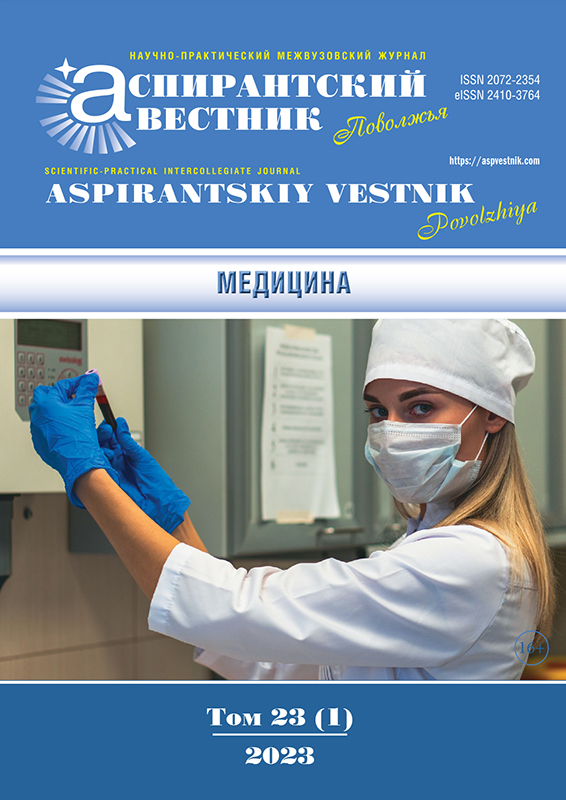Астенический синдром у реконвалесцентов иксодовых клещевых боррелиозов
- Авторы: Кулагина А.П.1, Суздальцев А.А.1
-
Учреждения:
- ФГБОУ ВО «Самарский государственный медицинский университет» Минздрава России
- Выпуск: Том 23, № 1 (2023)
- Страницы: 10-14
- Раздел: ИНФЕКЦИОННЫЕ БОЛЕЗНИ
- URL: https://bakhtiniada.ru/2410-3764/article/view/126186
- DOI: https://doi.org/10.55531/2072-2354.2023.23.1.10-14
- ID: 126186
Цитировать
Полный текст
Аннотация
Цель – изучить катамнез переболевших иксодовым клещевым боррелиозом в периоде реконвалесценции с наличием признаков астенического синдрома.
Материал и методы. В основу исследования вошли данные проспективного диспансерного наблюдения 37 пациентов с диагнозом «иксодовый клещевой боррелиоз, эритемная форма, средней степени тяжести, острое течение», находившихся на стационарном лечении в Клинике инфекционных болезней СамГМУ в 2016–2019 гг. Исследуемые были разделены на три группы согласно возрастным характеристикам: первая группа – от 18 до 35 лет (12 человек), вторая – от 36 до 55 лет (15 человек), третья – от 56 до 75 лет (10 человек). Обследование пациентов проводили после выписки из стационара на 14-й день, через 3, 12 и 36 месяцев. Для анализа астенического синдрома при иксодовых клещевых боррелиозах была использована шкала астении MFI-20 (The Multidimensional Fatigue Inventory).
Результаты. Длительность астении после перенесенных иксодовых клещевых боррелиозов сохраняется до 3 лет. Наиболее пристального наблюдения требуют пациенты в первые 2 недели периода реконвалесценции. Показатели физического и психологического здоровья у реконвалесцентов нормализуются в зависимости от возрастных особенностей и места их проживания. Психическая астения у лиц, проживающих в сельской местности, преобладает и сохраняется гораздо дольше, чем у горожан. Более подвержены общей и физической астении люди старшего возраста (от 56 до 75 лет).
Ключевые слова
Полный текст
Открыть статью на сайте журналаОб авторах
А. П. Кулагина
ФГБОУ ВО «Самарский государственный медицинский университет» Минздрава России
Автор, ответственный за переписку.
Email: a.p.kulagina@samsmu.ru
ORCID iD: 0000-0003-2422-4925
ассистент кафедры инфекционных болезней с эпидемиологией, врач-инфекционист специализированного консультативно-диагностического центра Клиник СамГМУ
Россия, СамараА. А. Суздальцев
ФГБОУ ВО «Самарский государственный медицинский университет» Минздрава России
Email: infect.samgmu@mail.ru
ORCID iD: 0000-0002-4688-1910
д-р мед. наук, профессор, профессор кафедры инфекционных болезней с эпидемиологией
Россия, СамараСписок литературы
- Lobzin YuV, Uskov AN, Kozlov SS. Lime-borreliosis (ixodic tick-borne borreliosis). SPb, 2000. (In Russ.). [Лобзин Ю.В., Усков А.Н., Козлов С.С. Лайм-боррелиоз (иксодовые клещевые боррелиозы). СПб., 2000].
- Solovey NV, Shcherba VV, Karpov IA, et al. The consequences of tick-borne borreliosis: myths and reality from the standpoint of evidence-based medicine. Infectious diseases. 2013;11(2):55-63. (In Russ.). [Соловей Н.В., Щерба В.В., Карпов И.А., и др. Последствия перенесенного клещевого боррелиоза: мифы и реальность с позиций доказательной медицины. Инфекционные болезни. 2013;11(2):55-63].
- Sumlivaya ON, Vorobyeva NN, Karakulova YuV. Postinfection syndrome in convalescents of ixodic tick-borne borrelioses. Journal of Infectology. 2014;6(4):27-32. (In Russ.). [Сумливая О.Н., Воробьева Н.Н., Каракулова Ю.В. Постинфекционный синдром у реконвалесцентов иксодовых клещевых боррелиозов. Журнал инфектологии. 2014;6(4):27-32].
- Cairns V, Godwin J. Post-Lyme borreliosis syndrome: a metaanalysis of reported symptoms. Int J Epidemiol. 2005;34(6):1340-1345. doi: 10.1093/ije/dyi129
- Ścieszka J, Dąbek J, Cieślik P. Post-Lyme disease syndrome. Reumatologia. 2015;53(1):46-8. doi: 10.5114/reum.2015.5055117
- Aucott JN, Rebman AW, Crowder LA, Kortte KB. Posttreatment Lyme disease syndrome symptomatology and the impact on life functioning: is there something here? Qual Life Res. 2013;22(1):75-84. doi: 10.1007/s11136-012-0126-6
- Wills AB, Spaulding AB, Adjemian J, et al. Long-term follow-up of patients with Lyme disease: longitudinal analysis of clinical and quality-of-life measures. Clin Infect Dis. 2016;62(12):1546-1551. doi: 10.1093/cid/ciw189
- Błaut-Jurkowska J, Jurkowski M. Zespół poboreliozowy. Pol Merkur Lekarski. 2016;40(236):129-33.
- Aucott JN. Posttreatment Lyme disease syndrome. Infect Dis Clin North Am. 2015;29(2):309-23. doi: 10.1016/j.idc.2015.02.012
- van den Wijngaard CC, Hofhuis A, Harms MG, et al. The burden of Lyme borreliosis expressed in disabilityadjusted life years. Eur J Public Health. 2015;25(6):1071-1078. doi: 10.1093/eurpub/ckv091
- Moniuszko A, Czupryna P, Zajkowska J, et al. Zespół post Lyme jako problem kliniczny. Pol Merkur Lekarski. 2009;26(153):227-30.
- Błaut-Jurkowska J, Jurkowski M. Zespół poboreliozowy. Pol Merkur Lekarski. 2016;40(236):129-33.
- Wong KH, Shapiro ED, Soffer GK. A Review of Post-treatment Lyme Disease Syndrome and Chronic Lyme Disease for the Practicing Immunologist. Clin Rev Allergy Immunol. 2022;62(1):264-271. doi: 10.1007/s12016-021-08906-w
- Vrijmoeth HD, Ursinus J, Harms MG, et al. Prevalence and determinants of persistent symptoms after treatment for Lyme borreliosis: study protocol for an observational, prospective cohort study (LymeProspect). BMC Infect Dis. 2019;19(1):324. doi: 10.1186/s12879-019-3949-8
Дополнительные файлы







